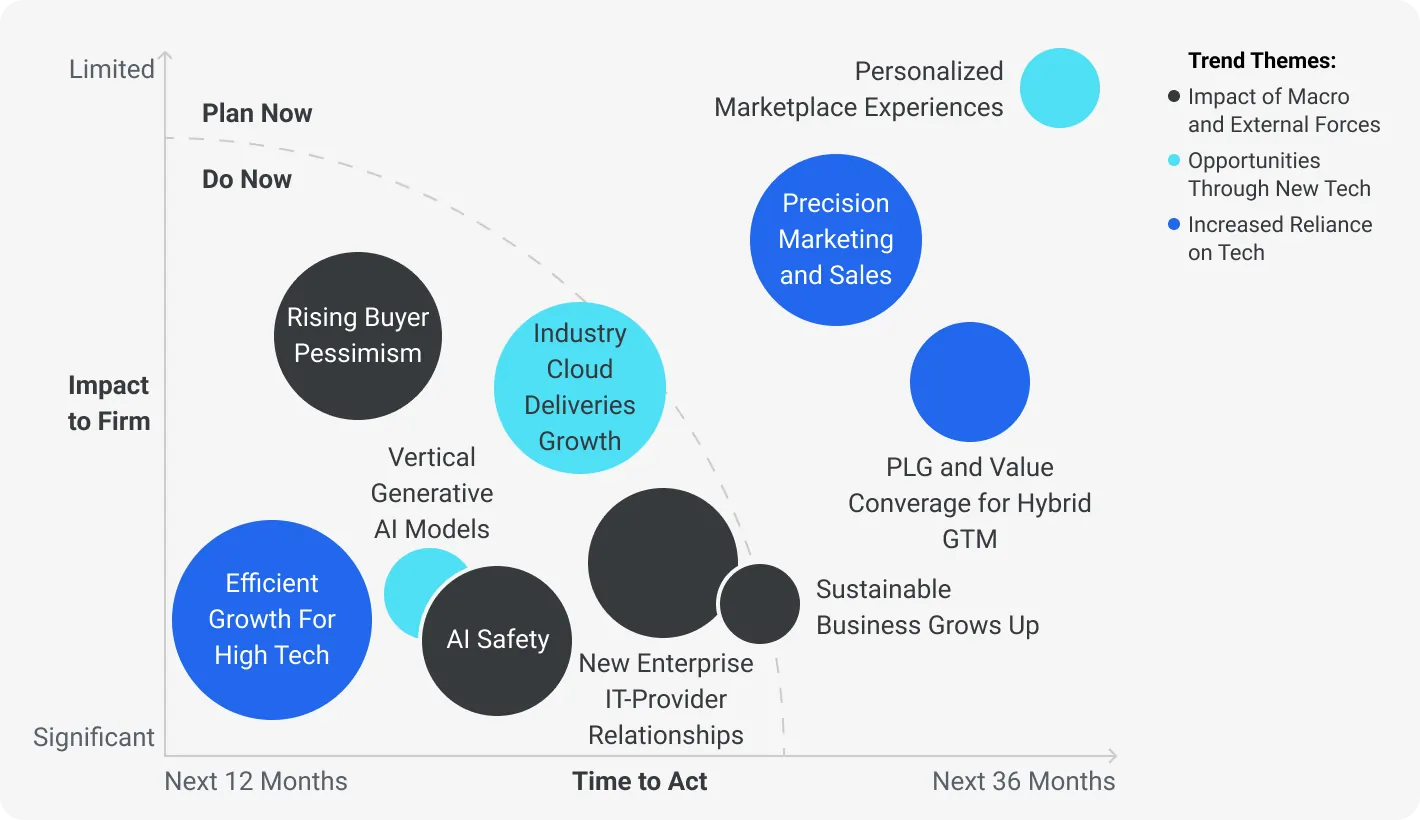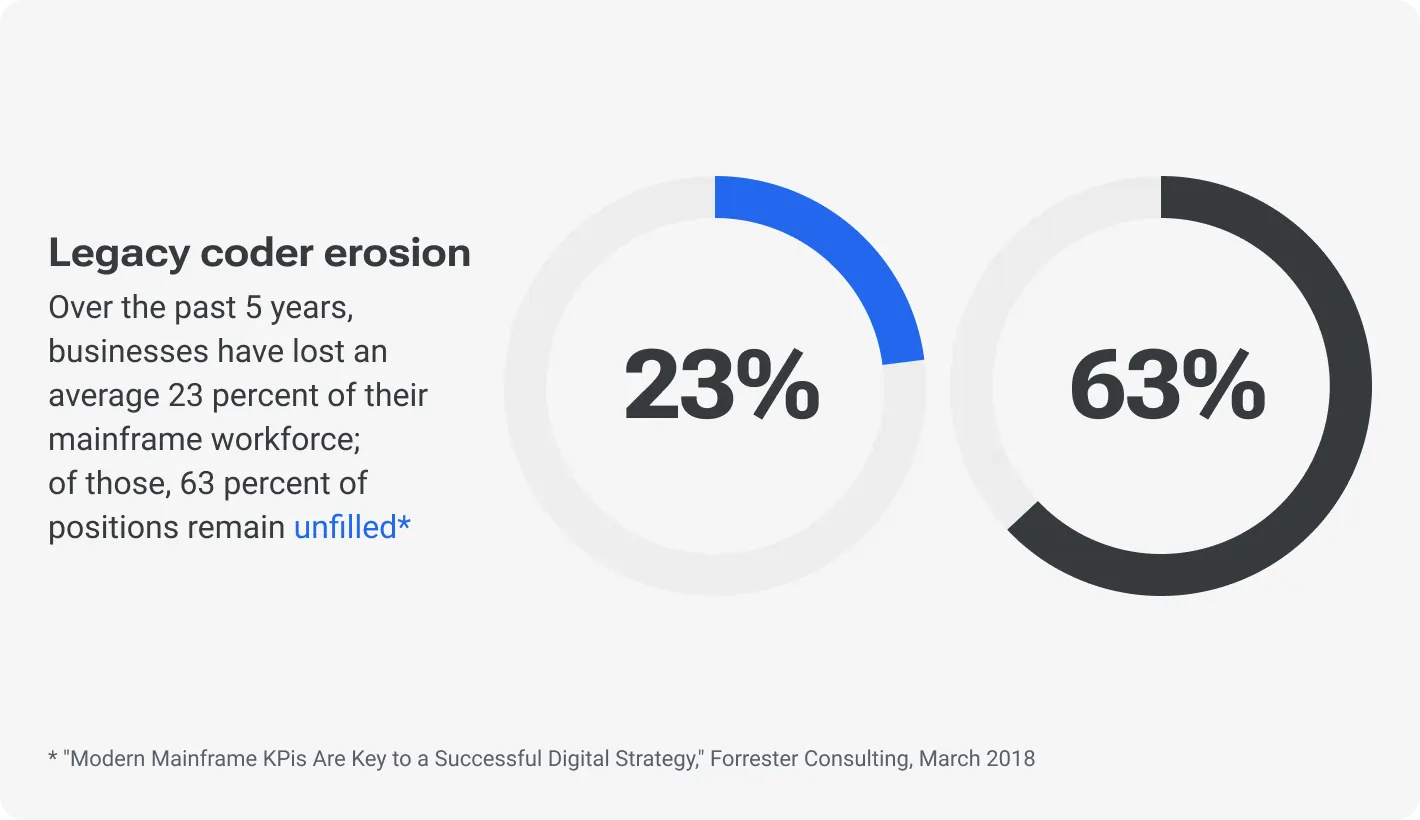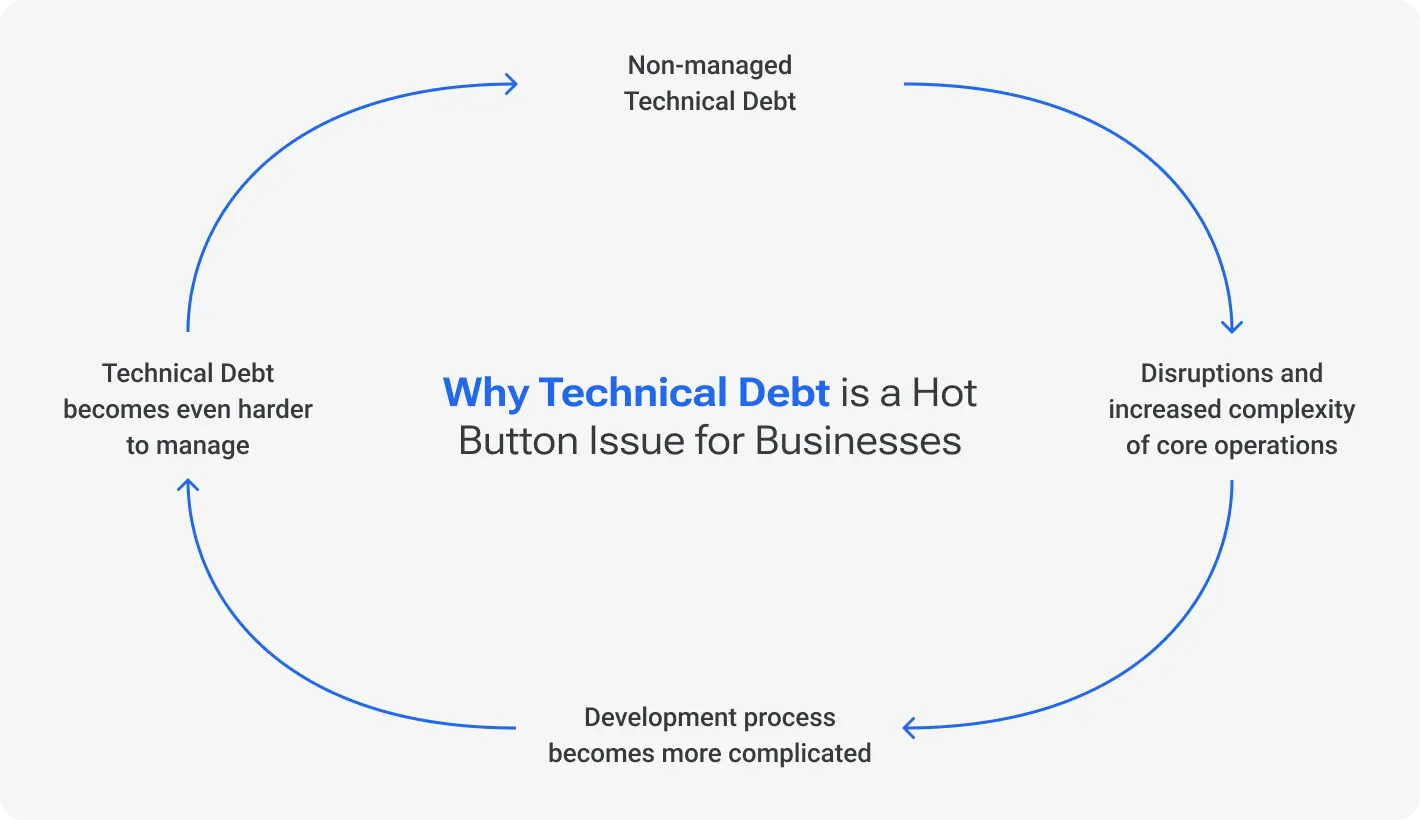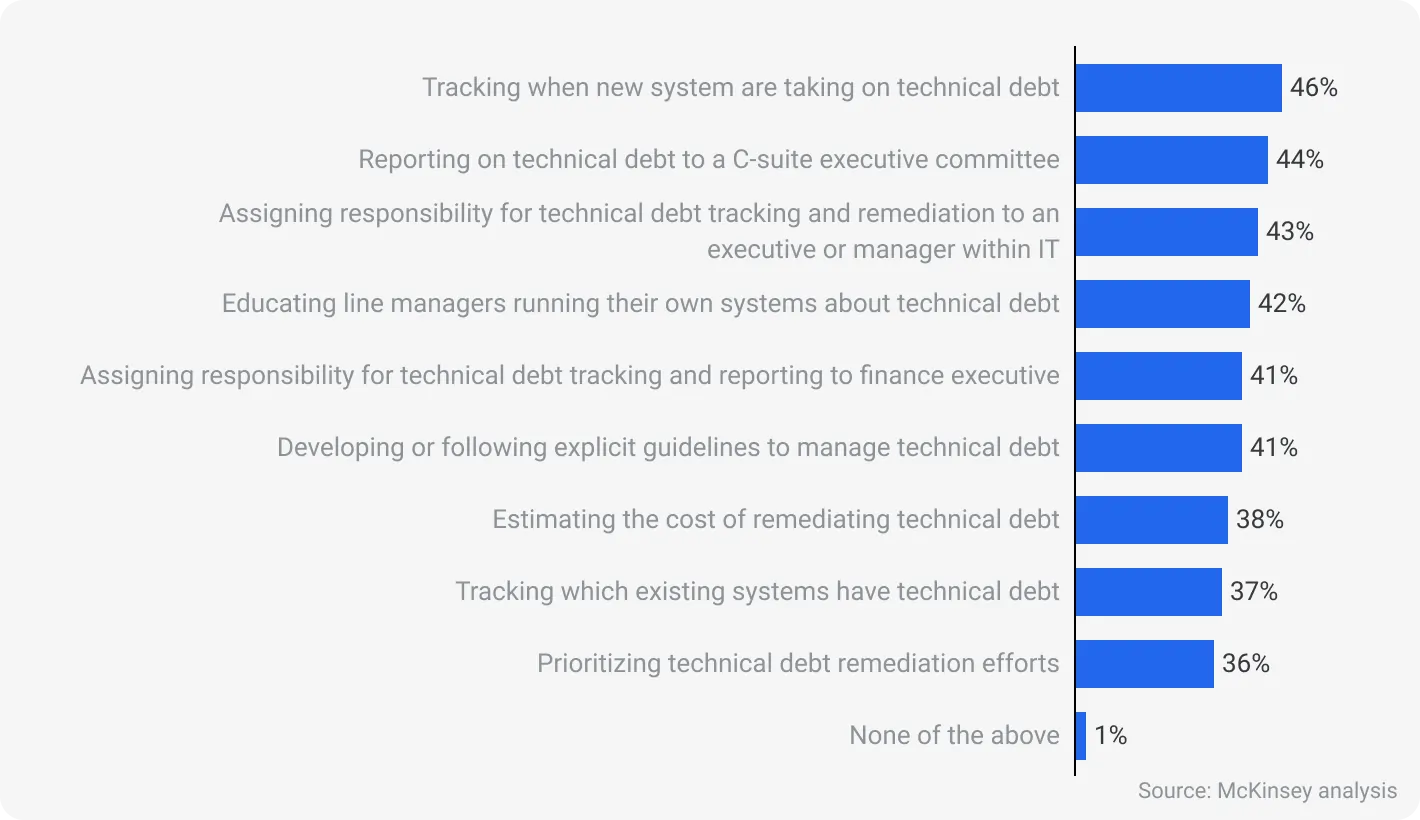Outsourcing to Czechia

How much does it cost to hire developers in Czechia?
Dec 2nd 25 - by Devico Team
Find out how much it costs to hire software developers in Czechia in 2025. Compare hourly rates, roles, and factors that impact pricing.
Hire
Hire by role
Hire Front-end developers
Hire Back-end developers
Hire Full-stack developers
Hire Android developers
Hire iOS developers
Hire Mobile developers
Hire AI engineers
Hire ML engineers
Hire Automation QA engineers
Hire Blockchain developers
Hire Data engineers
Hire Cloud engineers
Hire by skill
Hire JavaScript developers
Hire TypeScript developers
Hire Ruby on Rails developers
Hire React Native developers
Hire Flutter developers
Hire Golang developers
Hire React.js developers
Hire Python developers
Hire PHP developers
Hire .NET developers
Hire Java developers
Hire Laravel developers

Tech debt
April 04, 2024 - by Devico Team
Summarize with:
On February 5, Gartner named top technologies. That comes along with their speed — our tech environment is changing at a rate faster than ever before. According to them, 77% of IT leaders reported an increase in the pace of technological change over the past three years.
But while innovations unlock exciting possibilities, each shift in the technological landscape presents a potential pitfall: technology debt. McKinsey revealed that a staggering 70% of organizations grapple with significant code debt, incurring an average of 20-40% of their IT budget on technical debt reduction. This hidden liability can cripple agility, impede innovation, and ultimately threaten business viability.

Take Kodak for an example. Once a dominant force in the photography industry, Kodak's failure to adapt to the digital revolution resulted in its downfall. At that time, Kodak didn't believe in digital technology. We won't say they suffered much from technical debt, but we can generally assume that. After all, when faced with innovative technology, technological debt is bound to arise.
All those actions ultimately led to bankruptcy in 2012. We surmise you already understand the criticality of proactive technical debt management, particularly during periods of rapid technological change.
What is tech debt? You can find many tech-savvy technical debt definitions, but all the true understanding dawns on when the explanation is as simple as possible. At its core, technical debt is like procrastinating on homework. Imagine you have a big project due. But like any self-respecting student, you rush through it, leaving messy notes and unfinished sections. You may think, “Well done” since you finished quickly, but later on, you have to go back and fix everything properly, which takes even more time and effort.
Now, when it comes to technology changes, technological debt becomes just vital to understand. Now, old systems and software can become outdated or incompatible, much like using a Super Mario cartridge on a PS5 console. This mismatch creates challenges and complications, leading to what we call tech debt.
Legacy System Integration: Existing legacy systems can significantly slow down the speed of integration of new solutions. It's like trying to fit a square peg into a round hole. Listen to Deloitte: 47% of companies in the US struggle with integrating new technologies into their legacy systems.

Skill Gaps: Technologies will always be one of the most evolving and dynamic fields (at least for the near future), so nothing groundbreaking that the demand for new skills increases. For this reason, many companies face challenges in finding and retaining talent with the necessary expertise. McKinsey found that 87% of C-suite representatives surveyed believe there is a skill gap in the workforce (or it’s going to appear in the next 5 years).
New Frameworks and Libraries: Embracing new technologies often involves adopting new frameworks or libraries. While they offer exciting features, integrating them with existing code can introduce complexity and compatibility issues. A 2022 study by CAST Software found that organizations struggling to keep up with framework updates experience up to 20% higher maintenance costs due to code debt.
Security Risks: Great power brings great responsibility. So does new technology. They also bring new security risks with advancements. If we can believe IBM, the average cost of a data breach is USD 4.45 million, highlighting the importance of addressing security challenges during technology changes.
This is the first step towards effectively managing technical debt during technology changes. Taking these risks into account, you can take proactive measures and mitigate the impact of code debt, and ensure smooth transitions to new technologies.
Imagine building a Lego castle. You are not skilled enough, and it comes riddled with shaky foundations and mismatched pieces. Now, try adding new features or expanding it further. It becomes an exercise in frustration, constantly battling instability and compatibility issues. This is precisely the impact of unchecked technical debt on your software systems.

Technical debt can have significant consequences on system performance, leading to decreased efficiency and reliability. Let’s turn to the Ponemon Institute study. According to it, most surveyed IT professionals report that technical debt has a moderate to significant impact on system performance.
For example, take the case of 23andMe. Famous biotech company, probably, wasn’t thorough enough in tech debt and testing. As a result, 6.9M DNA Relatives users’ data was stolen. The organization was forced to allocate additional resources towards emergency maintenance and support, resulting in substantial unplanned expenses.
This underscores the tangible costs of pursuing revenue drive without reducing technical debt. As system performance worsens, any company faces increased operational risks and higher maintenance costs. Which hinders their ability to innovate and compete in today's digital economy.
Let's run through more consequences you might face.
Crippled System Performance: One more time — inefficient code, redundant processes, and outdated integrations create bottlenecks and slow down response times. There are many studies that prove that high tech debt leads to application performance issues more frequently, making user experience awful and business productivity inefficient.
Soaring Maintenance Costs: The task “to reduce technical debt” just can’t be a one-time expense. Fortunately or unfortunately, it's an endless battle. Fixing legacy code, updating outdated integrations, and refactoring poorly written sections all require time and resources. Capital One is saving USD 175M annually by tackling its technical debt.
Innovation Bankruptcy: With code debt, you can’t adapt to change. Integrating new technologies, deploying updates, and pivoting strategies become cumbersome exercises in overcoming past compromises. McKinsey’s report mentioned above points out: high technical debt leads to a 20% slower rate of innovation.
Security Vulnerabilities: Outdated libraries, unpatched systems, and poorly secured code within technical debt act as open doors for cyberattacks. Recall the IBM Security report we mentioned in the previous paragraph. We repeat: outdated software costs businesses an average of USD 4.45 million, underlining the security risks associated with unmanaged technical debt.
You Will Lack Flexibility: Technical debt can lock your company into outdated technologies and architectures, limiting your ability to adopt new innovations. By the way, McKinsey also stated that about 71% of IT leaders cite technical debt as a barrier to implementing new technologies.

Code Debt Becomes More Complex: Systems with significant code debt become more complex and difficult to maintain. This complexity hampers agility and responsiveness to changing market demands.
Higher Risk of Disruption: Technical debt increases the risk of system failures and downtime, posing a significant threat to business continuity. Accenture revealed that the automotive industry experiences disruptions due to technical debt even more than others, resulting in lost revenue and damaged reputation.
Resource Constraints: Technical debt reduction requires dedicated resources: time, budget, and talent. Yet, competing priorities and resource constraints can hinder efforts to tackle technical debt effectively. At the same time, most companies struggle with resource constraints when managing technical debt.
Open a new tab in your browser and type “how to reduce technical debt”. There is an entire sea of tips, quotes, and strategies, right? But most of them zero in on tackling existing code debt. And the main tip on how to reduce tech debt is just a proactive approach. That’s simple. Even during periods of technological change.
If wanting to keep up with technological change, remember — it’s not wise to fly blind. Conduct a thorough technical debt audit to understand where you actually are. Utilize tools like static code analysis, architecture visualization platforms, and code coverage analysis to identify the following:
Code quality issues: Be aware of code duplication, unused libraries, and potential security vulnerabilities. SonarQube or DeepScan can offer valuable insights.
Integration bottlenecks: Identify points where existing systems struggle to interact. MuleSoft or Boomi are your aiders for integration analysis.
Outdated Legacy Code: Pinpoint areas where outdated technologies or codebases might hinder your ability to leverage new solutions. CAST Highlight or Veracode can help evaluate legacy code health.
Pro tip: Eat this elephant bit by bit. Don't get overwhelmed by the sheer data volume. Assess all areas of potential impact and alignment with your technology change goals, and then prioritize.
Well, now you have a clear picture of your technical debt landscape. So, you are ready to create a strategic roadmap for technical debt reduction. Obviously, this plan should align with your other strategic initiatives.

Assess technical depth and center on addressing debt that impacts your change goals the most or poses the biggest security risks. Use risk-scoring systems to bring objectivity in prioritizing remediation efforts.
Break down tech debt remediation into manageable chunks that integrate seamlessly with your technology change timeline.
Explore options like open-source tools or cloud-based solutions to optimize resource allocation.
Pro tip: Don’t shy away from involving stakeholders across the company – from developers to business leaders – in the planning process to ensure alignment and buy-in. Also, adopt a microservices architecture and containerization to decouple dependencies. Kubernetes streamlines deployment and scaling, while microservices frameworks like Spring Boot or Micronaut enable modular development and independent scaling of services.
Why tech debt roadmaps don’t work
As we have said in previous sections, all these movements are far from a one-off action. No wonder McKinsey surveyed technology leaders in the United States, and 71% (!) reported that the development of their companies is rooted in the development of technology. So, keep up with technology evolving: continuously monitor the impact of your mitigation efforts and adapt your strategy as needed.
Track key metrics: Monitor code quality metrics, system performance indicators, and security vulnerabilities to measure the effectiveness of your tech debt reduction efforts. Datadog and Dynatrace can provide valuable insights for this reason.
Regular reviews: Conduct systematic reassessments of your code debt to identify new areas of concern and adjust your roadmap.
Au-to-mate: Automation tools for tasks like code testing, security scanning, and infrastructure management allow developers to free up time for strategic efforts. Use Jenkins or GitLab CI/CD, for example.
Pro tip: Nurture a culture of continuous learning and improvement within your team. Encourage developers to stay updated on best practices and leverage online resources and communities for knowledge sharing.
These are just a touch of the strategies you can use to transform technology changes from debt-inducing events into opportunities. Remember, proactive management is king.
Is there any point in repeating that a culture of cooperation is probably the most effective tool for technical debt remediation? But the thing is that this is leadership that plays a pivotal role in fostering this environment, promoting effective communication, cross-functional teamwork, and shared responsibility. How to create such an atmosphere where you are not afraid of taking ownership?
Crucial step for facilitating collaboration between IT and development teams. 93% of IT professionals believe that effective communication tools are essential for successful collaboration. Some of the most effective communication channels:
Instant Messaging Platforms: Slack, MS Teams, and Discord enable real-time communication and at least try to facilitate quick decision-making.
Project Management Tools: Popular Jira or Trello provide a centralized platform for tracking tasks, assigning responsibilities, and monitoring progress.
Video Conferencing: Zoom or Google Meet are probably the most popular platforms for virtual meetings that enable face-to-face communication and foster team cohesion.
In addition to using general communication channels, consider creating dedicated channels or chat groups for specific projects or initiatives.
One effective approach to collaboration is to set up cross-functional teams consisting of members from both departments. Such teams work collaboratively on technical debt remediation, sharing knowledge and coordinating efforts. By the way, agile practices like daily stand-up meetings or sprint retrospectives serve as a helping hand to open communication and promote a culture of transparency and accountability.
Organize workshops, training sessions, and brown bag lunches to encourage knowledge sharing across teams. It could cover two goals: level up your team's knowledge and allow your team members to manifest themselves as professionals. Don’t forget about internal wikis or LMSs to document best practices and lessons learned.
Pro tip: Take advantage of collaboration features in different platforms (e.g. Microsoft Teams) to facilitate cross-functional collaboration. Features like document sharing, screen sharing, and integration with other tools streamline communication and enable seamless collaboration between IT and development teams. It also saves a lion's share of working time if you check code or documentation in real-time.
Cultivate a culture of psychological safety where developers (as well as other team members) feel comfortable discussing technical debt (or any other topics) without fear of blame or retribution. Practice in "Making more mistakes". But ensure learning from these mistakes and celebrating successes.
Implement incentive programs (e.g., performance bonuses, public recognition) that reward team members for actively contributing to technical debt mitigation efforts.
Assign clear ownership for specific technical debt areas, empowering developers to make decisions and take initiative in addressing them. Make sure it’s easy and prestigious to participate in open-source projects related to technical debt management tools and best practices.
Pro tip: Gamification is a powerful tool to encourage engagement. Consider implementing point systems, leaderboards, or friendly competitions to motivate developers in tackling technical debt challenges. Yeah, it’s additional costs for merch or goods but, believe us, it will bring about more profit than you expect.
Psychological trick: Utilize the "social proof" principle by highlighting success stories or case studies of teams successfully managing technical debt. Showcase real-world examples of the benefits of shared responsibility, and your developers are more likely to buy into the importance of addressing technical debt collaboratively.
Effective implementation hinges on strong leadership. Leaders set the pace, allocate resources, and cultivate a culture that empowers teams to proactively manage technical debt. As we said before, leaders shouldn’t shy away from involvement and personal examples.
Let’s face it, budgets and other resources are corners of any table. You might hear about zero-budget changes, but it’s hardly true. At the same time, leadership must allocate sufficient resources, including budget, time, and talent, to effectively address technical debt. With the necessary resources, all the teams will be able to prioritize technical debt reduction efforts and invest in sustainable solutions.
And here we have two points:
1. Human Resources: Allocate skilled developers, architects, and quality assurance professionals to the technical debt mitigation team. Remember, talent is crucial, but experience is key to effective debt reduction.
2.Technological Resources: Invest in tools for static code analysis, code refactoring, automated testing, and CI/CD pipelines. These tools streamline the process and improve the efficiency of debt reduction efforts.
Famous visionary Bill Gates states, “We always overestimate the change that will occur in the next two years and underestimate the change that will occur in the next ten.” Well, it’s completely true. The importance of long-term planning and resource allocation can’t be overrated.
Shifting from a reactive to a proactive mindset towards technical debt is a matter of cultural change. Leaders should encourage open communication, solicit feedback from team members, and provide opportunities for professional development and growth.
Be an Example of Transparency: Encourage open communication about technical debt challenges and opportunities. Make it through your personal example. Also, ensure a safe space for developers to voice concerns and share ideas without fear of blame.
Celebrate Successes: Recognize and reward team members who actively contribute to technical debt reduction efforts. It’s one of the levels of Maslow’s Hierarchy of Needs — to be recognized. Publicly acknowledge their achievements to foster a sense of pride and ownership.
Clear Expectations are Key: Articulate clear expectations for technical debt management. Outline its importance within the broader business strategy and define key metrics for measuring progress.
Remember Jeff Bezos? Great. This wise billionaire once said, "The best customer service is no customer service." Apply this philosophy to technical debt; aim to prevent it from accumulating in the first place through proactive development practices and code reviews.
Provide opportunities for employees to enhance their skills and stay abreast of emerging technologies. There are many ways to ensure professional development: through training programs, workshops, and certifications.
Establish forums, such as brown bag sessions or tech talks, where employees can share their expertise, lessons learned, and best practices with their peers.
One more time: create a safe environment where team members feel encouraged to experiment, take risks, and learn from failures.
Lead by example (again, yeah!). Demonstrate a commitment to continuous learning and growth by participating in training programs, sharing insights from industry events, and actively engaging in professional development activities.
Prioritize lifelong learning and foster a culture of innovation. As a leader, you can empower teams to proactively manage any issues, including code debt, and drive sustainable technological growth within the company.
Technical debt reduction starts from understanding technical debt meaning. Once you clarify it in the context of technology changes, your company can identify specific challenges and risks associated with transitioning to new technologies. And on this stage, your best friends are comprehensive technology audits, strategic planning, and continuous monitoring. Armed with examples of tech debt, your team can mitigate your own issues and minimize their impact on system performance, maintenance costs, and future technological adaptations.
Remember the role of leadership. It plays a critical role in guiding organizations toward successful technical debt management and wise allocating resources. Prioritize collaboration between different teams and set up a culture of shared responsibility — it’s the only way to effectively address technical debt and drive sustainable technological growth.
Is Technical Debt Holding Your Business Back? Free yourself from the burden! Get a free quote on our technical debt management services and see how we can optimize your systems for future growth.
Outsourcing to Czechia

Dec 2nd 25 - by Devico Team
Find out how much it costs to hire software developers in Czechia in 2025. Compare hourly rates, roles, and factors that impact pricing.
Outsourcing to Czechia

Nov 25th 25 - by Devico Team
Compare Czechia and Poland for software outsourcing in 2025. Discover costs, talent, infrastructure, and which country fits your project best.
Outsourcing to Czechia

Nov 18th 25 - by Devico Team
A complete guide to outsourcing software projects to Czechia, learn about costs, talent, benefits, and how to build successful partnerships in 2025.